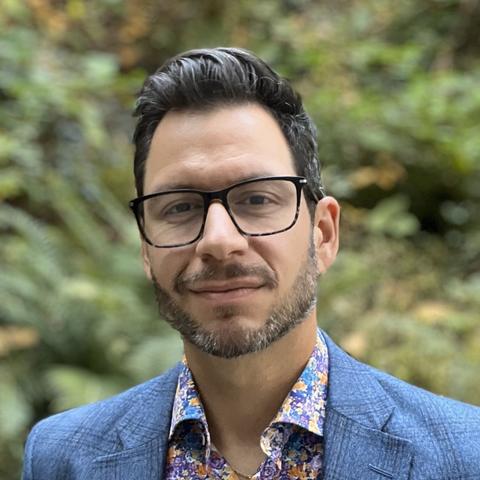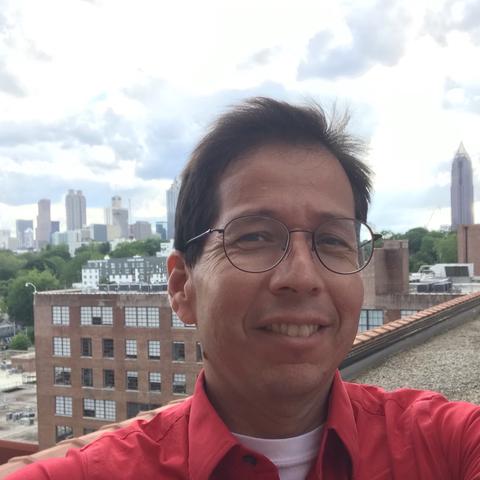
Section Branding
Header Content
Inside the Mirror by Parul Kapur
Primary Content
Winner of the AWP Prize for the Novel, Parul Kapur’s "Inside the Mirror" is set in the aftermath of colonialism, as an impoverished India struggles to remake itself into a modern state. Jaya’s story encompasses art, history, political revolt, love, and women’s ambition to seize their own power. In this episode, Peter and Orlando discuss this relatable and timeless pursuit of dreams by Atlanta's Kapur.

Orlando Montoya: Coming up in this episode:
Peter Biello: I didn't open this book for a history lesson. I opened this book for an emotional experience.
Orlando Montoya: I'm thinking, are they even allowed to study these things? I mean, given the constraints on women at the time.
Parul Kapur: Nobody actually anticipated that it would be as violent as it was.
Peter Biello: This podcast from Georgia Public Broadcasting highlights books with Georgia connections, hosted by two of your favorite public radio book nerds, who also happen to be your hosts of All Things Considered on GPB radio. I'm Peter Biello.
Orlando Montoya: And I'm Orlando Montoya. Thanks for joining us as we introduce you to authors, their writings, and the insights behind their stories, mixed with our own thoughts and ideas on just what gives these works the Narrative Edge. All right, Peter, I'm between books. I just finished one and I need a new one. So timing of this works out.
Peter Biello: Well, yeah. It does. I am here to help you. I've got a debut novel by an Atlanta author. This book has been decades in the making.
Orlando Montoya: Decades?
Peter Biello: Yeah. I mean, sometimes books just find a moment when the world is ready for it. And this is one of them. It's called Inside the Mirror, and I had a nice chat with author Parul Kapur in her writing studio about it earlier this month.
Orlando Montoya: And what's it about?
Peter Biello: It's about a pair of twin sisters who we meet when they're just about 19 years old. They live in India, and the book is set in the early 1950s, and it may, to some extent, have some of the same underlying political unrest in a book that you profiled on the show recently, Bengal Hound.
Orlando Montoya: Bengal Hound, which I will add, won the author of that book, Rahad Abir, a Georgia Writer of the year award for Best Author.
Peter Biello: That's right. Congratulations to him. So Bengal Hound was set in West Pakistan. This one is set in Bombay. It's closer in time to the partition that created West Pakistan in the first place. The British at this point have taken so much from India in terms of resources and wealth, and in 1947 that they left. The partition was created. So to get a sense of what's happening with these twins, you kind of gotta know what's happening with the country. And the book, to some extent, makes that clear early on. So the book opens in 1953, and Parul Kapur explains this moment in time really well.
Parul Kapur: What happened in 1947, when the British left, was they partitioned India into — It became India, and then it became West Pakistan and East Pakistan. And that partition, literally as they were leaving, created absolute catastrophe in the nation. Nobody actually anticipated that it would be as violent as it was. About 2 to 3 million people were killed just on the western border of India, which is West Pakistan. So the twin sisters, while their family is not directly impacted by this partition, they don't — they're not refugees because they're living in the city of Bombay, which was relatively unaffected because of its geographical location — But some of their relatives, who were affected in the Punjab and some who were living in Karachi and then they came and took refuge with these sisters because people had no homes. So you were — like my father's family — taking refuge with whatever relative you had in whatever city.
Orlando Montoya: So these twin sisters, they hear stories of their relatives, but they themselves are not threatened by violence, right?
Peter Biello: Correct. Yeah. They just witnessed the trauma that other people experience: family members, non-family members. And when you're young like that, you know, around 19 years old, it can leave a mark on you. And so these twin sisters, Jaya and Kamlesh, they use their art to process all this emotional trauma that they're hearing about. Jaya is an aspiring painter and Kamlesh is an aspiring dancer.
Parul Kapur: So Jaya starts drawing these horrible incidents that she's hearing about, you know, women relatives weeping in their apartment. She starts drawing the stories that she's hearing. Her sister Kamlesh has a different impulse, which is they find out about dance classes in the neighborhood and she starts taking dance. So these are all — the arts also become part of their way of processing this emotional grief.
Peter Biello: And I will add that in my reading of the book, at least, that the way they practice their art isn't simply for some kind of catharsis or, you know, emotional healing. They just — they honestly love what they do. Jaya spends a lot of time drawing and painting Kamlesh as she dances, she's trying really hard to sort of capture motion on the page.
Orlando Montoya: I'm thinking, are they even allowed to study these things? I mean, given the constraints on women at the time?
Peter Biello: Yeah, to some extent they are allowed. Their father, who is considered kind of progressive for the time, allows them to meet with some approved teachers, art teachers. But these are kind of considered extracurriculars, right? Their father has chosen different professions for both of them. Jaya is studying medicine. She spends a lot of her time going to classes for that. And they're scenes where she's dissecting bodies, for example. And sometimes she paints these cadavers from memory and produces some really stunning work. And Kamlesh is compelled to study to become a teacher. So, there's a conflict here. They — they get a taste of life as an artist, but they are expected to abandon that in favor of these practical things that their father has chosen for them.
Orlando Montoya: Something practical, like an arranged marriage?
Peter Biello: That's part of this as well. So Jaya is meeting secretly with Kirti. He's a young man who's also studying to be a doctor. There's a romantic subplot there. They're meeting in secret. Really some lovely scenes there. As a reader, I'm firmly in the "Follow Your Dreams" camp. I want Jaya and Kamlesh to break free from these social constraints that say being a dancer is disgraceful because you have to show off your body; the social constraints that, say, cavorting with the crew of modern artist painters is taboo. Parul Kapur makes social disgrace a real risk in this book.
Parul Kapur: Social disgrace in India is a very serious thing. It's like if you bring shame on your family, it's almost as if they lose so much standing in society that they lose their ability to survive. Your reputation is part of your value and your power in this society and your ability to thrive and survive in it.
Orlando Montoya: So the family considers that they've brought shame onto them?
Peter Biello: That's always a risk. I can't say whether or not they do, because that would be giving it away, right? That's the central question that we're thinking about: "Oh my God, are they going to do something that puts this entire family in a bad light?"
Orlando Montoya: I want to come back to something you talked about earlier, about how long this book took to publish.
Peter Biello: Oh, yeah. Yeah, this is I mean, you talk to enough writers, you'll occasionally hear a story like this. Like, "I worked on this book for 30 years," and finally it found its moment. So — so Parul Kapur started writing this book in the '80s, and she spent a year as a journalist in India. Then she went to get her MFA in creative writing at Columbia. That's a well-known writing program. And she got a lot of advice that is fairly common in the writing world, like, "short story collections don't sell. You gotta write a novel. It's got to be a novel." So she — so she wrote the first draft of this book, with two sisters, after 25 years of writing, without finding a publisher for it, she put it aside. And then she was working as a journalist, and she met, film director Deepa Mehta. Is that a familiar name to you?
Orlando Montoya: No. I don't know that.
Peter Biello: So she was filming the adaptation of Salman Rushdie's Midnight's Children, when she met Parul Kapur. And Kapur asked Mehta to to read her work, which she did. She was one of the first people to read the complete — completed first draft. Gave her a lot of advice on this. And that got Kapur thinking about the book as a movie. And she says that helped her create a map for revision.
Parul Kapur: And so I just made that map, and I put it away, and I said, "Someday, if somebody's interested in publishing it, then I will have this map to revision."
Peter Biello: And that was about a decade ago.
Orlando Montoya: So somebody became interested.
Peter Biello: Yeah. She won the AWP Prize for the Novel, which accepted manuscripts at any length. She said that, you know, the manuscript was so long, she had a hard time finding writing contests to submit it to. But there was no limit for AWP's contest. I should mention, we talked about AWP way back when we talked with Dan Sinykin about the publishing industry. You remember that conversation we had?
Orlando Montoya: Yes. From Emory.
Peter Biello: Yeah, that's the giant Association of Writing Programs Group, kind of an industry group that had that giant book fair. They're very into producing books of literary quality, which this one is. So she won the Prize for the Novel, the AWP prize, and then the University of Nebraska Press picked it up, but they wanted it to be about 120,000 words, which was about half of the length of the manuscript. So she did a lot of work on it, including an intense period of revision that lasted about four months.
Parul Kapur: I did a lot of work in four months. I brought it down, and I think it's a much better story and a better novel, and I injected a lot of new things also, because obviously I had developed as a person in the 10 years since I put it away. So I had new ideas. So it's a kind of combination of, you know, the original story and then what I have learned over the course of all these years and that I was able to put in at the end.
Orlando Montoya: So does the book move quickly or does the length really show?
Peter Biello: I do think this book is as tight as it needs to be.
Orlando Montoya: And so what gives this book the Narrative Edge?
Peter Biello: I think this book does a really good job of creating an atmosphere of a time and a place. Like, this is a fraught moment for India. We're still referring to it in this time period as Bombay. That's where we are in history. Her parents are kind of what you would expect for that time. I mean, even though they are progressive, they say the kinds of things that you've seen — you might have seen in stories before, right? They're like, "This is not for you. This is not for our family. You need to do x, y, z." But that element, I think, holds up. It creates just the right amount of tension. And Jaya and Kamlessh are twins, but individuated enough to make you really feel for them and I think that's what carries through. I also feel like she could have fallen into a trap of making the history weigh so heavily on the plot that you just kind of say, "oh, come on, get over it already. Like — like, I didn't open this book for a history lesson. I opened this book for an emotional experience." And you don't get the tired history. You get the emotional experience of following these two sisters as they pursue a relatable and and timeless pursuit: following their heart, following their dreams.
Orlando Montoya: All right. The book is called Inside the Mirror by Parul Kapur. Peter, thanks for telling me about it.
Peter Biello: Happy to.
Orlando Montoya: Thanks for listening to Narrative Edge. We'll be back in two weeks with a brand-new episode. This podcast is a production of Georgia Public Broadcasting. Find us online at GPB.org/NarrativeEdge.
Peter Biello: You can also catch us on the daily GPB News podcast Georgia Today for a concise update on the latest news in Georgia. For more on that and all of our podcasts, go to GPB.org/Podcasts.








